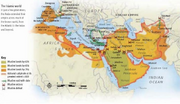The Early Muslim conquests, also known as the Arab conquests or the Rise of Islam, was a period of Islamic history which occurred from 622 to 750 AD as the Arab Muslim armies of the Rashidun, Umayyad, and Abbasid caliphates emerged from the Arabian Peninsula and conquered the Byzantine Levant, Egypt, the Caucasus, and parts of Anatolia, the Persian Sassanid Empire in Mesopotamia and Central Asia, the Berbers of North Africa, the Visigoths of the Iberian Peninsula, the nomadic peoples of Central Asia, and the White Huns and Indian dynasties of the Indian Subcontinent, spreading the Islamic faith as they went. By the time of the Abbasid Revolution in 750 AD, the Islamic empire stretched from the Iberian Peninsula and Morocco in the west to Central Asia and the Indian Subcontinent to the east, and had defeated some of the most powerful empires in the world, such as the Byzantinse, Persians, and the Chinese.
Background[]
In 610 the prophet Muhammad retreated into the desert and received the first of a series of revelations that were to lead to the proclamation of Islam.
Arabia was a place apart, remote, and inhospitable: its people were nomadic herders and desert traders. While the very northernmost areas appear to have been occupied, first by the Persians and then by the Romans, the main part of the peninsula remained largely undisturbed.
A warlike attitude was forced on Muhammad from the beginning: the rulers of his native Mecca saw his message as destabilizing and he and his followers eventually had to leave. After the Hijra - the move to Medina in 622 - they had to fight for their survival. Inspired by their sense of mission, they triumphed at the Battle of Badr in 624. Though defeated and almost destroyed at Uhud in 625, Muhammad and his followers recovered to win the Battle of the Trench in 627. Three years later they captured Mecca. By the time the prophet died in 632, his followers had grown accustomed to the idea that believers had to fight to make the truth prevail. His successor, the first caliph Abu Bakr, brought all the Arab tribes under Islamic rule.
History[]
When, in 632, the prophet Muhammad died, he left behind not just a new religion but a cause for which his followers were prepared to fight and die. Till then a collection of warring tribes, the Arabs had found a shared ideal, an identity in which they could unite. Within a century, the prophet's message had been carried over an area reaching from northern Spain to Central Asia.
The Arab warriors had no heavy weaponry or armor; they relied principally on their swords, which were straight and double-edged and carried in wooden scabbards. Their main weapons, though, were speed and surprise, as well as a passionate commitment to their beliefs. The Arabs had also been equipped for war by their way of life. Nomadic pastoralists, they had grown up tough, with superlative riding skills. They had the fineset horses in the world: fast, resilient, and intelligent, but also docile. The Arabian camel, or dromedary, was used as a beast of burden rather than a mount, but it was far quicker and more versatile than any wheeled cart.
Abu Bakr's challenge as first caliph was bringing together all the Arab tribes. Only under his successor, Umar ibn al-Khattab, from 634-44, did the campaign of conquest begin in earnest. It did so with explosive violence - Umar's armies pouring out of the Arabian Peninsula to attack the southern borders of the Byzantine empire. In 636 Islam smashed a Byzantine force at Yarmuk, now on the border between Syria and Jordan. Two years later Jerusalem was taken.
The Arabs had conquered Syria, Palestine, and Egypt by 641; they had also defeated the Sassanids. As yet, they were too few in number to take far-reaching areas of the Persian Empire, but they quickly made new converts and consolidated their position.
In the following decades, the empire-ubilding effort was hampered by internal divisions. At Karbala in Iraq in 680, the army of Umayyad Caliph Yazid I overcame that of Husayn ibn Ali, the prophet's grandson. The massacre that ensued left a legacy of bitterness, and caused the split between the rival Islamic traditions of Sunni and Shia which continues to this day. Even so, Iran was secured and Afghanistan taken, while an advance-guard poured across the Hindu Kush into what is now Pakistan. In the west, Tripoli was taken and ships seized the island of Cyprus.
Muawiyyah I's Umayyad dynasty, with its capital at Damascus, imposed a degree of unity and order on the Arab world. That world was still growing: in the early years of the 8th century, Arab armies advanced westward from Libya across the Maghreb. In 711 the first raiding party of Arabs and Islamicized Berbers crossed the Straits of Gibraltar into Spain: Tariq ibn Ziyad's warriors crushed the defenders sent to fight them. By 718 virtually the whole of the Iberian Peninsula lay in Muslim hands.
Aftermath[]

Map of Islamic expansion, 634-800
The Arab attempt to conquer Europe was thwarted at the Battle of Poitiers in 732. However, the Islamic hold on the Middle East remains strong to this day. The Moors, as the Arabs were also known, would gradually be pushed southward through Spain during the Reconquista. Even so, the Islamic kingdom of al-Andalus was to flourish for several centuries.
The long-term consequences of some of these events can be traced in the modern era. The split between Sunni and Shia underlay the bitter conflict between Iraq and Iran in the 1980s and added additional complexity to the occupation of Iraq. The collision between the Islamic East and the West also occurred in the war between NATO forces and the Taliban in Afghanistan.
